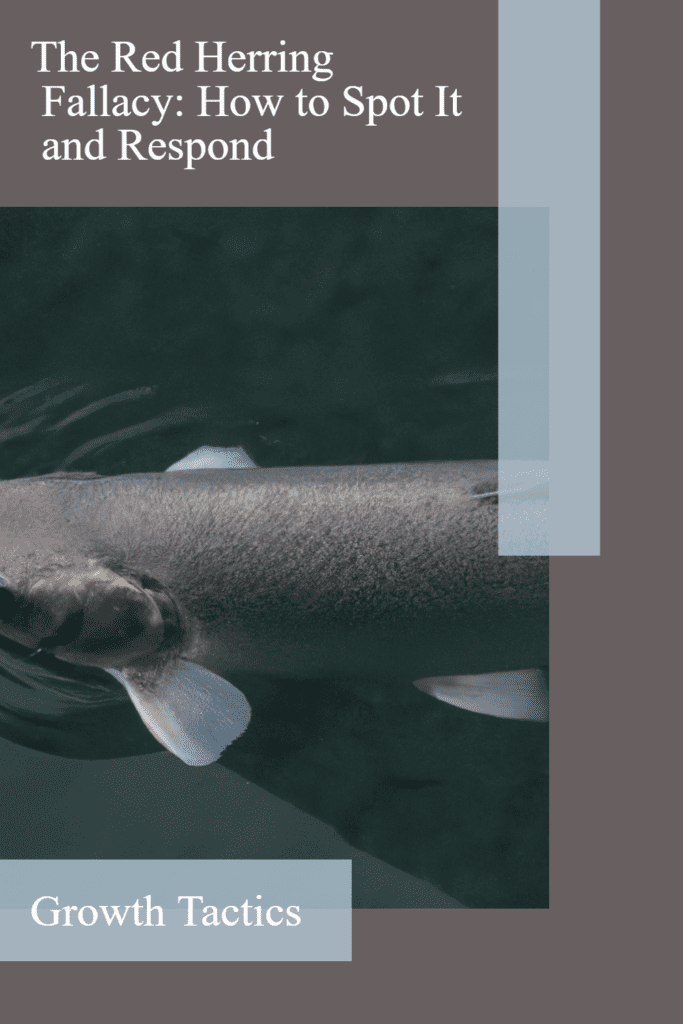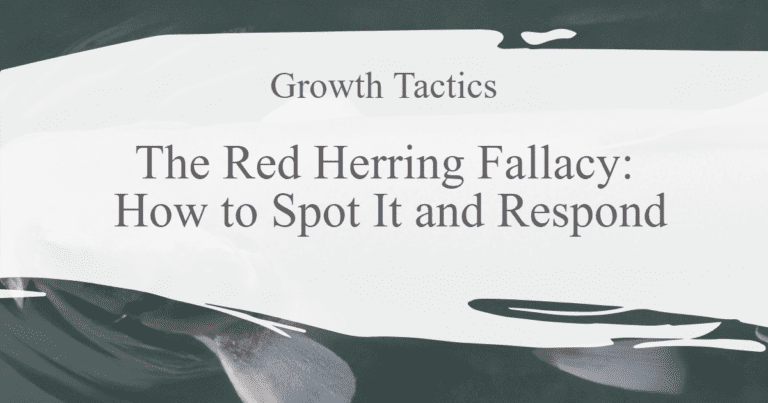Have you ever found yourself in a discussion or argument where someone suddenly brings up a completely unrelated topic, diverting your attention from the main issue? If so, you may have encountered a logical fallacy known as the red herring.
In this blog post, we’ll explore the red herring fallacy, its definition, and examples of how it can be used to distract from the main point. By understanding this fallacy and learning how to spot and respond to it, you’ll be better equipped to have effective and meaningful discussions. So, let’s dive in!
Jump To Section
What is a Red Herring and How is it Used?
A red herring is a type of logical fallacy that occurs when someone introduces an irrelevant or unrelated topic to a discussion or argument.
The purpose of this fallacy is to divert attention away from the original topic, often misleading or misdirecting the conversation. The term “red herring” actually originates from the practice of using strong-smelling cured herring to divert hunting dogs from the scent of their prey.
Examples of Red Herrings in Arguments
Imagine you’re having a friendly conversation with someone about the importance of eating a balanced diet to maintain good health. Suddenly, out of nowhere, they bring up a completely unrelated topic like the latest sports game or celebrity gossip. Boom! That’s a classic red herring right there.
Another example could be discussing the need for stricter gun control laws to reduce gun violence. Instead of addressing the issue at hand, someone starts talking about personal freedom and the importance of the Second Amendment. While the Second Amendment is an important topic, it’s a bit of a detour from the main conversation about gun violence and potential solutions.
Here’s another one: Imagine a debate about increasing funding for education to improve the quality of schools. Suddenly, someone jumps in and brings up a completely different topic, like how lowering taxes would benefit small businesses. While taxes and small businesses are important subjects, they don’t really address the main issue of how to improve education.
These examples illustrate how red herrings can pop up in conversations, taking us off track and diverting attention from the main points being discussed. They can be quite sneaky, my friend, and it’s important to keep an eye out for them.
By recognizing these examples of red herrings, you’ll be better equipped to spot them in real-life discussions. Remember, we’re all on this journey of learning and growing together, so let’s keep exploring logical fallacies and becoming better thinkers!
How to Spot a Red Herring
Spotting a red herring can be challenging, especially when it’s skillfully used to distract from the main issue. However, there are a few telltale signs to look out for. First, be wary of sudden changes in topic that seem unrelated to the original discussion. If someone introduces a completely different subject out of nowhere, it may be a red herring.
Additionally, pay attention to whether the new topic is designed to elicit an emotional response rather than addressing the logical aspects of the argument. Red herrings often rely on emotional manipulation to divert attention.
How to Respond to a Red Herring
So, you’ve spotted a red herring in a discussion or argument, and now you’re wondering how to respond to this diversion tactic. Don’t worry, my curious friend, I’m here to help you navigate through this. Let’s explore some effective strategies for responding to a red herring.
1. Stay focused on the main issue
The first thing to remember is to stay focused on the main topic at hand. Acknowledge the irrelevant topic that has been introduced, but politely steer the conversation back to the original point. You can say something like, “That’s an interesting point, but let’s not forget our main concern, which is…”
2. Challenge the relevance
Another approach is to question the relevance of the red herring. Ask probing questions that highlight the lack of connection between the diversion and the main issue. For example, if someone starts talking about celebrity gossip during a discussion about climate change, you could calmly ask, “How does this relate to reducing carbon emissions?” By challenging the relevance, you bring the conversation back on track.
3. Reframe the argument
When faced with a red herring, you can also reframe the argument to redirect the focus. Take a step back and look for the underlying assumptions or core values at play. By reframing the discussion around these foundational aspects, you can guide the conversation back toward the main issue. For example, if the diversion is about defense spending instead of funding public schools, you can say, “While defense is important, let’s remember that our focus here is on ensuring quality education for our children. How can we address that without neglecting other priorities?”
4. Emphasize the facts
In responding to a red herring, it’s important to rely on facts and evidence rather than getting caught up in emotional or irrelevant arguments. By emphasizing the facts that support your position on the main issue, you can steer the conversation back to a logical and constructive path. Keep the discussion grounded in objective information, and avoid getting sidetracked by emotional appeals or unrelated anecdotes.
5. Maintain a respectful tone
Lastly, it’s crucial to maintain a respectful and calm tone throughout the conversation. Remember, our goal is to have a meaningful and productive discussion, even when faced with distractions like red herrings. Avoid becoming defensive or confrontational, as that may only escalate the situation. Stay composed, listen attentively, and respond thoughtfully.
By employing these strategies, you’ll be better equipped to respond to red herrings and keep the conversation focused on the real issues. Remember, we’re all here to learn and grow as thinkers, so keep an open mind and foster an atmosphere of curiosity and respect. Together, we can navigate through logical fallacies and have more meaningful discussions.
The Importance of Avoiding Logical Fallacies
While it may seem like a minor issue, falling into the trap of logical fallacies can have serious consequences, especially when it comes to important decisions or arguments. That’s why understanding and avoiding logical fallacies is crucial for effective communication and critical thinking.
When we talk about logical fallacies, we’re referring to errors in reasoning that undermine the validity and soundness of an argument. These fallacies can take many forms, such as circular reasoning, straw man arguments, ad hominem attacks, or the red herring fallacy we explored earlier. Whatever form they take, they all have one thing in common: they distract from the real issues at hand and can lead us to false conclusions.
The importance of avoiding logical fallacies extends beyond intellectual curiosity or academic debate. In our everyday lives, we’re constantly faced with decisions that require critical thinking and sound reasoning. Whether it’s choosing a political candidate, evaluating scientific research, or making an important personal choice, we need to be able to rely on logical and well-founded arguments. By avoiding logical fallacies, we ensure that our thinking is as clear and accurate as possible.
So, how can we avoid falling into the trap of logical fallacies? The key is to stay vigilant in our thinking and to challenge assumptions and arguments whenever necessary. We need to be aware of the most common types of logical fallacies and recognize them when they appear in our own thinking or in the arguments of others. We also need to be willing to question our own beliefs and assumptions and to consider alternative viewpoints that may challenge our preconceptions.
Ultimately, avoiding logical fallacies requires a commitment to clear and critical thinking. It means being open to feedback and constructive criticism and being willing to revise our beliefs and arguments in light of new evidence or reasoning. It’s not always easy to avoid logical fallacies, but by maintaining an attentive and reflective mindset, we can become better thinkers and more effective communicators.
Summary
To recap, a red herring is a logical fallacy that occurs when an irrelevant topic is introduced into a conversation or argument in an attempt to distract or divert attention from the main issue. It’s important to be able to spot red herrings by looking out for sudden changes in the conversation and emotional appeals.
When faced with a red herring, respond by politely bringing the discussion back to the main topic or by asking questions that challenge the relevance of the diversion.
By avoiding logical fallacies and staying focused on the facts, we can engage in meaningful and productive discourse. So, the next time you encounter a red herring, remember to stay on track and don’t let yourself be misled!
Key Takeaways
- A red herring is a logical fallacy that diverts attention from the main issue by introducing an unrelated topic.
- Red herrings can be identified by sudden changes in topic and emotional appeals.
- When faced with a red herring, respond by bringing the conversation back to the main issue or questioning the relevance of the diversion.
- Understanding and avoiding logical fallacies is important for effective communication and critical thinking.
FAQ
What is a red herring fallacy?
A red herring fallacy is a sneaky way to distract someone from the main point of a discussion. It’s like when someone changes the subject to avoid sticking to the argument. Staying focused eliminates confusion and keeps communication clear.
Where does the term “red herring” come from?
“Red herring” originates from training hunting dogs. A smelly fish would be dragged across a trail to throw dogs off scent. In conversations, it’s a distraction technique. Knowing its origins can help you recognize it in action.
Can you give examples of red herrings in arguments?
Sure, let’s make this practical. Imagine discussing the importance of healthy eating. Suddenly, your friend starts talking about their favorite team’s game. That’s a classic red herring. I see this often when discussing safety regulations, and the topic shifts to unrelated personal freedoms.
How can I spot a red herring?
Spotting a red herring takes practice. Pay attention to sudden changes in the topic that divert attention. If the new point seems out of place, it might be a red herring. I find asking myself, “Does this address the original issue?” helps.
What are effective strategies to respond to a red herring?
- Stay focused on the main issue: Gently steer the discussion back.
- Challenge the relevance: Ask clear, pointed questions about the connection.
- Reframe the argument: Bring it back to the core values or facts.
- Emphasize the facts: Ground the conversation in evidence.
- Maintain a respectful tone: Keep things calm and respectful for productivity.
Why is it important to avoid logical fallacies like the red herring?
Avoiding logical fallacies like the red herring is crucial for honest interactions. These distractions harm clear thinking and decision-making. Effective leaders and problem-solvers value clarity and truth.
How can I improve my critical thinking to avoid logical fallacies?
Improving critical thinking is a journey. Stay curious and challenge your own assumptions. Familiarize yourself with common fallacies. Listen actively and seek feedback. This will enhance your problem-solving and leadership skills.


